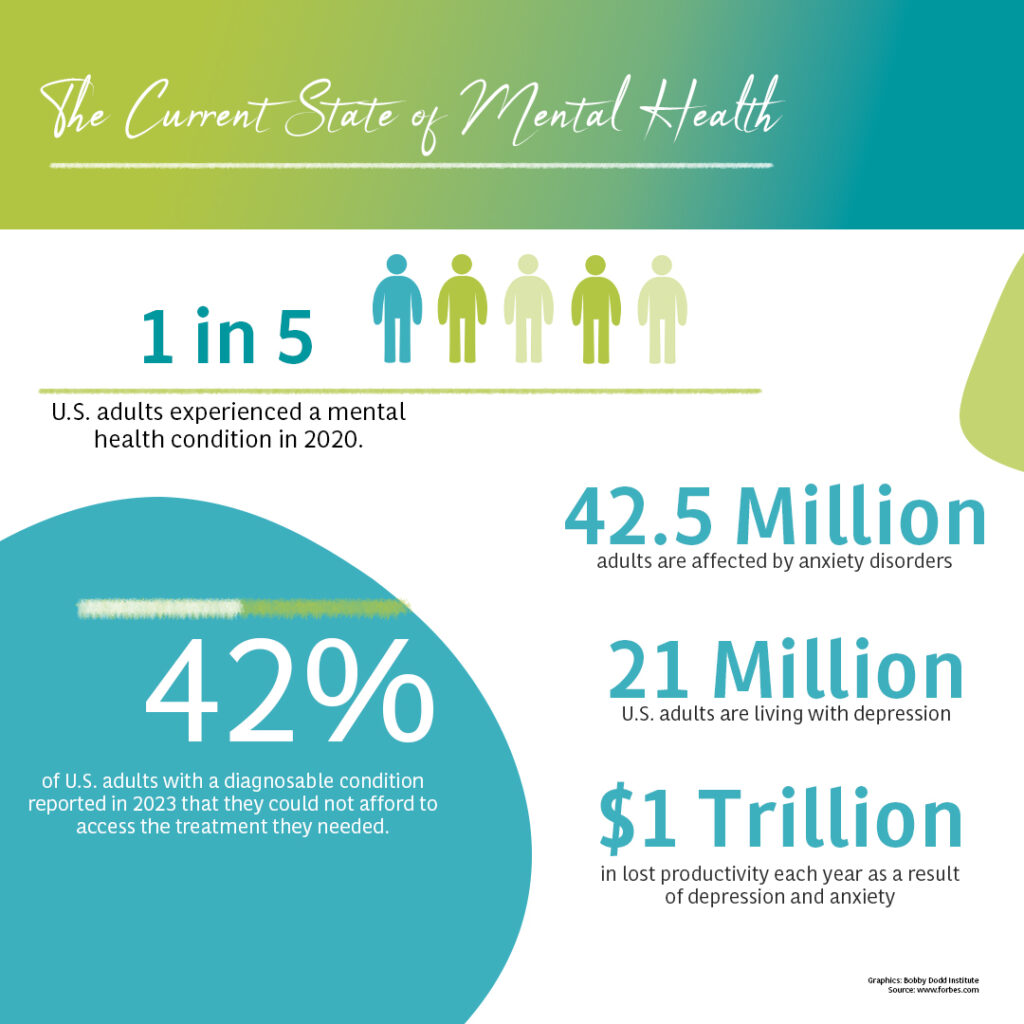One in five adults each year experiences mental condition. This is according to the latest numbers by the National Alliance of Mental Illness. As the numbers are growing, efforts to bring awareness to the problem and reduce the stigma surrounding the community are increasing.
One such effort is Mental Health Awareness Month, observed during May every year, to bring attention to the issue. It is also a way to help us equip with the knowledge we need to look after our own mental health, and to empower people who may be struggling. Mental Health Awareness Month began in 1949 in the United States, started by Mental Health America. As described by the Substance Abuse and Mental Health Administration, mental health includes our emotional, psychological, and social well-being, affecting how we think, feel, and act, and determines how we handle stress, relate to others, and make choices.
As we slowly awaken from the recent pandemic, we keep seeing the negative effects of it on our mental health. According to a scientific brief released by the World Health Organization, the prevalence of anxiety and depression increased by a massive 25% in 2020. But, on the other hand, the unusual situation brought this issue to the forefront in a way that it hasn’t been before. We have started normalizing the conversation around the problem and reducing the stigma, led by the Gen Z population. “Tik Tok and other social media platforms share a lot of information on this to a wide audience. Sometimes it may be misinformation but overall, I think this is a helpful trend to get the information out there, to help normalize conversations about mental health,” commented Julie Sharp, an Account Manager at FEI Behavioral Health, which specializes in services ranging from EAP and organizational development to workplace violence prevention and crisis management.
Mental Health by the Numbers
Millions of people are affected by mental health problems every year. According to the data provided by the National Alliance of Mental Illness, 21% of U.S. adults experienced a mental health condition in 2020. Suicide is the second leading cause of death among people aged 10-14, according to the CDC. One in six youth aged 6-17 experiences a serious mental health disorder.

Stigma in the Workplace
When it comes to mental health and the workplace, we have a lot to learn. According to one of the latest reports conducted by Modern Health and Forrester Consulting, more than 50% of the surveyed employees are afraid that a future mental health issue may cost them their job.
Another problem is the fact that people who experience mental ill-health may be labeled by others and seen as their condition, and not as a person. Many may feel excluded and even be blamed for their condition.
Surveys of US employers show that about half of them are reluctant to hire someone with past psychiatric history or currently undergoing treatment for depression. Approximately 70% are reluctant to hire someone with a history of substance abuse or someone currently taking antipsychotic medication. Employers are more likely to hire someone with a physical disability.
“We are aware of how people’s recovery can be held back by the barriers that stigma creates, often through problems encountered at work. Stigma may make people reluctant to admit that they may have difficulties, and this can delay treatment and support. To reduce the stigma, we need better education to be able to bust some of the myths that are out there about this,” says Julie Sharp.
What Can Each of Us Do to Reduce Stigma and Move the Conversation on Mental Health Forward?
Pay Attention
To help reduce the stigma around mental health, we need to educate ourselves, including learning how to recognize the signs of stress or mental ill-health.
To do this, be sure you are paying attention to what is going on around you and how your colleagues are doing. Maybe you have noticed one of the top performers at your workplace has changed lately. Perhaps they are often calling in sick, their performance is dropping, or they have started exhibiting poor time-keeping abilities. These may be you first signs that this person may be going through a hard time. Look for patterns such as increased use of alcohol, drugs, tobacco, or caffeine; frequent headaches and backaches; withdrawal from social contact; poor judgment or indecision; constant tiredness or low energy; unusual displays of emotion, such as frequent irritability or tearfulness; working more slowly; missing deadlines; increased difficulty concentrating; appearing numb or emotionless; withdrawing from work activity; overworking; forgetfulness; or having difficulty with work transitions or changes in routines.
“Pay attention to what is going on around you and how your colleagues are doing. When someone fails to earn support early on, it affects not just them but their colleagues, families, and friends, and in extreme cases, it can also cause liability or reputation issues for the organization. Early intervention is essential. To do that, we need to be able to recognize the signs that our colleague is struggling so that we can reach out with our concern and point them to resources that will help move them to a healthier place,” says Julie.
Never ignore or delay acting, and never try to diagnose a condition unless you are a qualified professional. Make sure you ask questions, listen, and refer to appropriate resources when needed.
Recognizing the signs in someone else may be difficult, but it is even harder to see them when you are the one who is affected. This is why it is important to learn those signs, and be open to feedback from others, so you also can get the support you need early on to maintain your own resilience and wellbeing.
Watch Your Language
By educating ourselves and making some adjustments in the words that we use, we help increase awareness and reduce the stigma around mental health. If you are feeling unsure what language to use, use this helpful guide created by The Mental Health Coalition.
Educate Yourself
To educate yourself, there are organizations such as the National Alliance of Mental Health, CDC, WHO, and many others that offer resources and educational content to help you learn more about different mental health conditions. Being knowledgeable will make it easier to recognize the signs early and take appropriate action by spreading the word, raising awareness, and allowing you to make a significant difference.
Focus on the Person Not the Condition
Always approach the person with understanding and never treat them as if they are different. Never shift the focus from the person to their condition. Everyone may be affected in different ways, no matter how similar the condition they experience may be.
Tell Your Own Story
At one point or another, everyone has been in a difficult situation. Share your own story. Be an example. If you are open about your own experiences, people will relate to you and become more open about their own experience around mental health.
Bobby Dodd Institute Behavioral Health Program
Bobby Dodd Institute (BDI) is changing the way individuals with intellectual and developmental disabilities receive care with their new Behavioral Health Program. Launched in August 2022, this unique program is currently serving clients at both Atlanta and Decatur BDI’s locations.
BDI’s Behavioral Health Program is based on the latest research and offers a comprehensive approach to addressing mental health issues, autism spectrum disorders, and intellectual and developmental disabilities in adolescents and adults aged 15 and up.
The program offers a range of services, including individual group, and family counseling, counseling regarding behavioral concerns and behavioral modification, as well as development of young adult skills through psychosocial interventions to address transitioning to work, social skills development, and more.
Dr. Brandon Printup, the Clinical Director of the program, brings over 15 years of experience working across various treatment settings and has maintained a general practice serving children and adolescents, adults, and families. With his specialty areas, including addiction, trauma, and family systems, Dr. Printup is highly effective in treating a range of issues such as grief, loss, anxiety, depression, and relationship issues.
BDI’s Behavioral Health Program is an important step in providing a more comprehensive care for people of all abilities.
“Our goal is to apply user-centered approach, meeting our clients where they are currently at in addition to providing support to their families. We aim to educate families about mental health and different abilities. Our goal is to provide the least restrictive services I addition to providing the families with community support and resources,” says Brandon Printup.
The goal of the program is to establish a strong clinical pathway for the people it serves and to offer support to their families.



